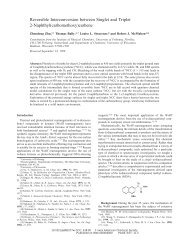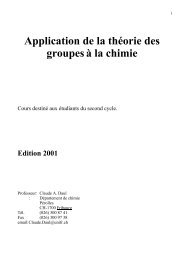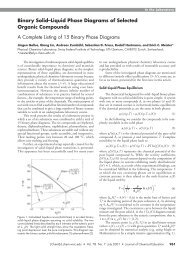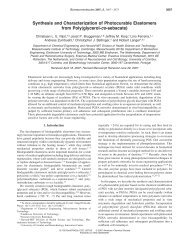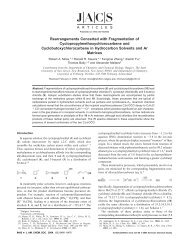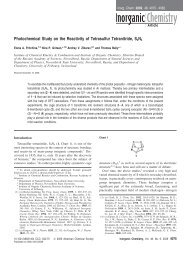Ultrafast Spectroscopic and Matrix Isolation Studies of p-Biphenylyl ...
Ultrafast Spectroscopic and Matrix Isolation Studies of p-Biphenylyl ...
Ultrafast Spectroscopic and Matrix Isolation Studies of p-Biphenylyl ...
You also want an ePaper? Increase the reach of your titles
YUMPU automatically turns print PDFs into web optimized ePapers that Google loves.
<strong>Ultrafast</strong> Spectroscopy <strong>of</strong> Arylnitrenium Cations ARTICLES<br />
Scheme 1<br />
studying the solution-phase chemistry <strong>of</strong> nitrenium cations,<br />
which allowed the measurement <strong>of</strong> their lifetimes, the determination<br />
<strong>of</strong> their UV-vis <strong>and</strong> IR spectra, <strong>and</strong> the determination<br />
<strong>of</strong> rate constants for reactions with selected nucleophiles, in<br />
aqueous solution. In the early 1990s, Falvey’s group reported<br />
the first laser flash photolysis (LFP) study on nitrenium<br />
cations, which they obtained by photoisomerization <strong>of</strong> anthranilium<br />
cations, 13 i.e., precursors that inherently carry a<br />
carbonyl group on the aromatic ring. Later, they developed more<br />
general photochemical precursors such as N-aminopyridinium<br />
cations. 13-15,23,24<br />
In principle, any nitrenium cation can be generated from such<br />
precursors, but monosubstituted N-aminopyridinium cations<br />
(pyr +- NHR) are unstable. The most convenient way to generate<br />
monosubstituted nitrenium cations, RNH + , was developed by<br />
McClell<strong>and</strong> et al. who photolyzed aryl azides in water to<br />
generate singlet nitrenes, which are subsequently protonated to<br />
form nitrenium cations. 1-4 This method works particularly well<br />
when the singlet nitrene to be intercepted has a relatively long<br />
lifetime (>10 ns) in aprotic solvent at ambient temperatures.<br />
In this manner, p-biphenylylnitrenium cation 6, produced by<br />
protonation <strong>of</strong> nitrene 5, was readily detected by transient UVvis<br />
spectroscopy (Scheme 2). 1-4 Zhu et al. subsequently studied<br />
this nitrenium cation in water using time-resolved resonance<br />
Raman spectroscopy <strong>and</strong> assigned the spectra with the aid <strong>of</strong><br />
DFT calculations. 25<br />
Similarly, Michalak et al. produced fluorinated arylnitrenium<br />
cations in acidic acetonitrile solution by flash photolysis <strong>of</strong> the<br />
corresponding aryl azides. 26<br />
Although product studies indicate that the parent singlet<br />
phenylnitrene (τ ≈ 1 ns, organic solvents) can also be protonated<br />
in acidic aqueous solution, LFP studies failed to produce the<br />
(23) Srivastava, S.; Toscano, J. P.; Moran, R. J.; Falvey, D. E. J. Am. Chem.<br />
Soc. 1997, 119, 11552-11553.<br />
(24) Srivastava, S.; Ruane, P. H.; Toscano, J. P.; Sullivan, M. B.; Cramer, C.<br />
J.; Chiapperino, D.; Reed, E. C.; Falvey, D. E. J. Am. Chem. Soc. 2000,<br />
122, 8271-8278.<br />
(25) Zhu, P.; Ong, S. Y.; Chan, P. Y.; Poon, Y. F.; Leung, K. H.; Phillips, D.<br />
L. Chem. Eur. J. 2001, 7, 4928-4936.<br />
(26) Michalak, J.; Zhai, H. B.; Platz, M. S. J. Phys. Chem. 1996, 100, 14028-<br />
14036.<br />
transient spectrum <strong>of</strong> the phenylnitrenium cation. 4,27 From<br />
competition studies its lifetime was estimated to be ∼30 ps,<br />
which is too short to allow its observation by nanosecond<br />
spectroscopy. Thus, ultrafast time-resolved techniques are<br />
necessary to directly observe certain nitrenium ions in solution.<br />
The intrinsic drawback <strong>of</strong> McClell<strong>and</strong>’s method is that the<br />
protonation <strong>of</strong> the singlet nitrene has to be rapid enough to<br />
compete with its other deactivation channels, such as intersystem<br />
crossing to the lower energy triplet state <strong>and</strong> intramolecular<br />
rearrangement (see Scheme 1).<br />
o-<strong>Biphenylyl</strong>nitrene 8 <strong>and</strong> 1-naphthylnitrene 15 are wellknown<br />
short-lived singlet nitrenes, whose lifetimes in CH3CN<br />
(16 <strong>and</strong> 12 ps, respectively) 28,29 are controlled by intramolecular<br />
cyclizations (Schemes 3 <strong>and</strong> 4). Thus, even if protonation can<br />
compete with the other decay channels, ultrafast spectroscopic<br />
methods would be required to resolve the formation <strong>of</strong> these<br />
nitrenium cations.<br />
A number <strong>of</strong> nitrenium cations have been characterized by<br />
transient absorption spectroscopy experiments, <strong>and</strong> a good deal<br />
has been learned about their lifetimes <strong>and</strong> rate constants for<br />
reactions with other species. However, there are few direct<br />
experimental measurements <strong>of</strong> the structure <strong>of</strong> these short-lived<br />
species. Time-resolved infrared absorption spectroscopy (TRIR)<br />
experiments have recently been used to obtain vibrational spectra<br />
<strong>of</strong> several nitrenium cations, generated by flash photolysis <strong>of</strong><br />
aminopyridinium salts. The first such study confirmed that the<br />
diphenylnitrenium cation has an iminocyclohexadienyl cationlike<br />
structure. 24<br />
The lifetimes <strong>of</strong> singlet arylnitrenes are temperature dependent.<br />
At low temperatures the thermally activated intramolecular<br />
rearrangements become slow, <strong>and</strong> singlet nitrene lifetimes<br />
increase to ∼100 ns <strong>and</strong> are limited by intersystem crossing to<br />
the lower energy triplet state (cf., Schemes 1-4). This led us<br />
to hypothesize that photolysis <strong>of</strong> aryl azides in argon/HCl<br />
matrices might lead to efficient capture <strong>of</strong> singlet nitrenes <strong>and</strong><br />
produce nitrenium cations that are persistent under the conditions<br />
<strong>of</strong> matrix isolation, which would allow their convenient<br />
spectroscopic analysis. Also, matrix conditions lead to higher<br />
resolution spectra <strong>of</strong> molecules than those that can be obtained<br />
in solution, particularly in the case <strong>of</strong> vibrational spectroscopy. 30<br />
In this study, we will apply ultrafast UV-vis spectroscopy<br />
to study reaction rates <strong>and</strong> mechanisms, complemented by<br />
matrix isolation spectroscopy, to collect structural information.<br />
As a first substrate in these experiments, we choose<br />
p-biphenylyl azide 4 because both the corresponding nitrene<br />
5 28,29 <strong>and</strong> the expected nitrenium cation 6 2,4 (Scheme 2) are well<br />
characterized. We will then proceed to extend this approach to<br />
o-biphenylyl azide 7 <strong>and</strong> 1-naphthyl azide 14 which produce<br />
short-lived singlet arylnitrenes <strong>and</strong> hitherto unknown nitrenium<br />
cations.<br />
(27) Fishbein, J. C.; McClell<strong>and</strong>, R. A. Can. J. Chem. 1996, 74, 1321-1328.<br />
(28) Burdzinski, G. T.; Gustafson, T. L.; Hackett, J. C.; Hadad, C. M.; Platz,<br />
M. S. J. Am. Chem. Soc. 2005, 127, 13764-13765.<br />
(29) Burdzinski, G.; Hackett, J. C.; Wang, J.; Gustafson, T. L.; Hadad, C. M.;<br />
Platz, M. S. J. Am. Chem. Soc. 2006, 128, 13402-13411.<br />
(30) Hayes, J. C.; Sheridan, R. S. J. Am. Chem. Soc. 1990, 112, 5879-5881.<br />
J. AM. CHEM. SOC. 9 VOL. 129, NO. 26, 2007 8381




